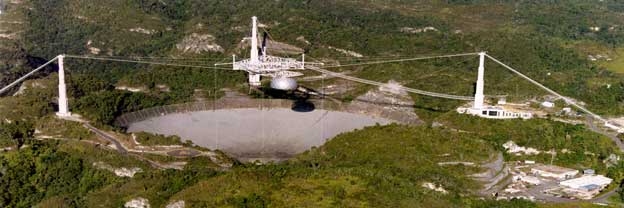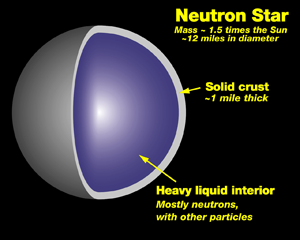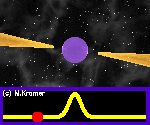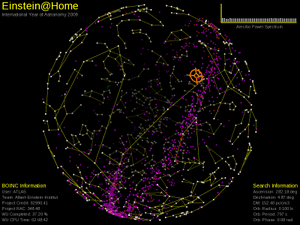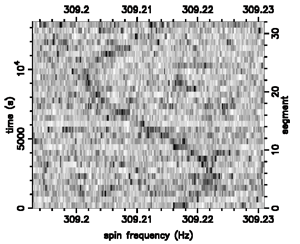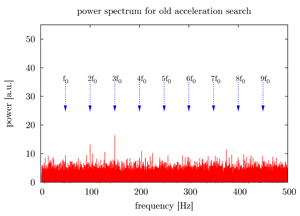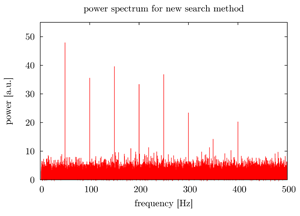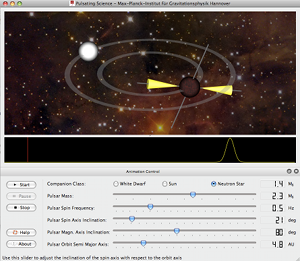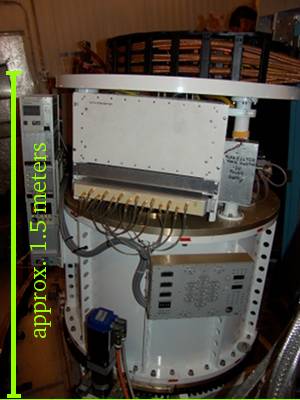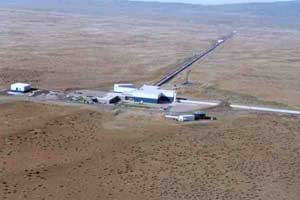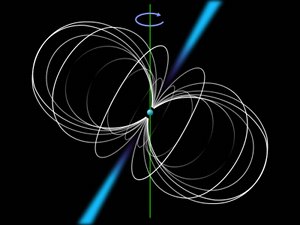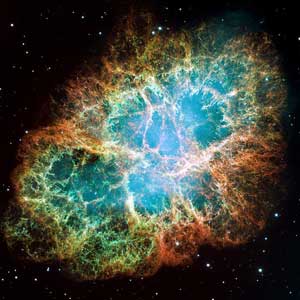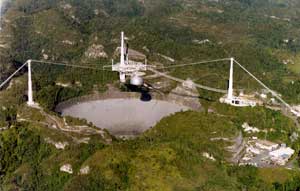Arecibo Binary Pulsar Search:项目背景
Arecibo Binary Pulsar Search 的项目背景
什么是脉冲星?
When a massive star uses up all its nuclear fuel for energy production, it collapses under its own weight. The core of the star gets compressed so much that the protons and electrons within it combine to become neutrons. The resulting object is called a neutron star. (If the neutron star weighs more than two or three solar masses, it collapses further and forms a black hole.)
Radio pulsars are neutron stars with an immensely strong magnetic field. They rotate and accelerate electrons in their vicinity to close to the speed of light. These electrons emit polarized light (called coherent curvature radiation) in a narrow cone. When this cone sweeps across the line of sight to Earth, we see the radio emission brighten regularly, just like a lighthouse. Some radio pulsars are also seen in visible light, X- and gamma rays.
So far, pulsars have been the primary way that neutron stars can be observed. About 1800 of them are known today. Only a tiny fraction of pulsars is in binary systems where their masses can be determined. The known sample is not large enough to determine a firm upper mass limit, which would in turn give more detailed insight into the physics of such extremely dense forms of matter.
All Pulsars in a Catalogue
Browse the ATNF online pulsar catalogue that contains the most recent information on the 1800 known pulsars.
为什么我们要搜寻双星系统中的脉冲星?
Most pulsars are weak sources and require the use of large radio telescopes to detect them. Astronomers have scanned the complete sky with various telescopes and detected pulsars in the Milky Way and nearby globular clusters. Pulsars in other galaxies are out of reach of our detectors. Most known pulsars were only found by "integrating" their signal: superposing a large number of pulses in a coordinated way to make the actual "pulse" signal stand out from the "static".
This procedure doesn't work as well for pulsars in most short-period binary systems. Since we see most binary systems from the side or inclined, the time-delay between the near and far points of the orbit smears out the signal making it harder to distinguish it from the noise. That's unfortunate since many stars are not solitary but members of a binary system. Thus, a significant fraction of pulsars are being missed in the surveys.
我们的搜寻是如何进行的?
Our search is a a "blind search". A priori we do not know the exact distance, spin frequency, and orbital parameters of the radio pulsar that might be hidden in a data set. We have to search over a wide range in these parameters to maximize detection probability.
Interstellar space is filled with clouds of gas and dust. Some of these clouds have temperatures of about 8,000 K and contain free electrons. These clouds will disperse radio waves travelling through them, meaning that higher radio frequencies arrive earlier than lower ones. The more electrons in the gas along the line of sight, the larger this time-delay. Radio telescopes observe a wide band of radio frequencies, so this dispersion has to be corrected for. Since the exact amount of dispersion depends on the unknown distance to the pulsar and the number of electrons along this distance we correct for 628 trial values of dispersion and search each of the resulting data sets independently. This process is called "dedispersion" and done on the Einstein@Home servers.
Since we are ignorant of the orbital parameters of the binary we have to try thousands of possible orbital templates, each corresponding to a different pattern of Doppler spinup and spindown. For each of these templates the data are corrected for the full Doppler effect of the corresponding orbit. This is the first step done on the computers attached to the project. The next step is to test whether there is a radio pulsar present in that data set on that (or a similar) orbit. This is done by using a frequency analysis (Fourier transform) that will recover the spin frequency without smearing.
Because the signals of radio pulsars are not sinusoidal but pulsed, the frequency analysis will show frequency components at the fundamental frequency (the intrinsic spin frequency) and at higher harmonics (integer multiples of the fundamental frequency). Summing these components is a well-known trick in pulsar searches and significantly increases the sensitivity of the search. This summation is the last step done on the users' computers. Finally a list of the most significant candidates is reported back to the Einstein@Home servers and analyzed by the project scientists.
我们的新搜寻方法和以前有什么不同?
Searches for binary radio pulsars so far were called "acceleration searches" or "sideband searches". The former correct for the varying time-delays by using an approximation of the binary orbit which is valid only if the observation time is much less than the orbital period of the binary system. The latter is efficient only when many binary orbits are visible during the observation time. There is a gap between those methods where both experience a large loss in sensitivity. Our search is using data sets covering 5 minutes of observation. Thus, the acceleration search becomes significantly less sensitive for orbital periods shorter than 50 minutes. The sideband search loses sensitivity for orbital periods longer than 3 minutes.
The new search method will close the resulting gap and can correct for binary periods down to 11 minutes, meaning that we can "see" up to half an orbit of such a binary (with its strongly varying Doppler effect). The figures to the right illustrate the progress achieved by using this procedure.
Interactive Binary Pulsar Simulation
Explore the Doppler effect in a binary pulsar system by downloading the "Pulsating Science" 3D visualisation software. Generate, view, and modify binary pulsar systems and their radio pulsations. The lower picture on the right shows a screenshot from this interactive simulation.
Follow the links below to get started and download an executable for your system (3D graphics drivers required):
* Microsoft Windows (XP/Vista, 32 bit) * Apple Mac OS X (Intel, 32 bit) * GNU/Linux (from 2.6.8, Intel x86)
我们在搜寻过程中使用的数据从何而来?
We use data from an ongoing survey made with the largest radio telescope in the world, the 305 meter Arecibo Observatory, Puerto Rico. It is equipped with a detector that can observe seven adjacent fields in the sky simultaneously: the Arecibo L-band Feed Array, or "ALFA". The search for pulsars has been one of ALFA's main tasks, carried out by an international, open group of astronomers, the ALFA Pulsar Consortium.
The survey contains 5 minute long observations for each ALFA field in the sky. In these data sets, our pulsar search aims to find binaries with orbital periods longer than eleven minutes.
Further links
The National Astronomy and Ionosphere Center (NAIC). is the research facility that operates the Arecibo telescope.
The Arecibo telescope photo gallery contains pictures of the telescope from construction to the present time.
A detailed description of the Arecibo telescope can be found here.
这个子项目对搜寻引力波有帮助吗?
When matter accelerates through space, it changes the curvature of spacetime. These changes propagate through space at the speed of light in form of gravitational waves. The more compact and massive the matter is and the more it accelerates, the more intense are the gravitational waves that are emitted. Therefore, close binary systems with compact components like neutron stars and/or black holes are a strong, continuous source for gravitational waves.
With the results from this pulsar search, we improve our understanding of how many binaries with neutron stars may be out there in total. Moreover, we get a set of pulsar binaries with known sky positions and orbital parameters. Pulsars can emit gravitational waves by a variety of mechanisms in the sensitive frequency range of ground-based detectors.The results from the radio pulsar search enable us to carry out so-called "targeted searches" for gravitational waves from binary pulsars in data of the LIGO, VIRGO, or GEO 600 gravitational wave observatories.
Furthermore, these new pulsars can serve as calibration sources for the gravitational wave space observatory LISA which should be launched by the end of this decade. Here, the gravitational waves emitted from the orbital motion in the mHz range would be detectable.
Gravitational Wave Observatories
LIGO Homepage
VIRGO Homepage
GEO 600 Homepage
LISA Homepage
我们可以从脉冲星中了解什么?
Since their discovery in 1967 by Jocelyn Bell and Anthony Hewish in Cambridge, UK, radio pulsars are one of the most exciting fields of astronomical research. Although there is a basic understanding of how they work, many details of the physical processes have yet to be determined. For example: how many charged particles are accelerated by the ultra-strong magnetic field? What kind of particles are they? How exactly do they move? At what distance from the neutron star's surface is the radiation created that the radio observatories detect?
And more mysteries are buried below the surface: what is the interior composition of such an object? Is there a core that consists not of neutrons but of their constituents, the quarks? Our new project should help to answer these questions. Moreover, these fascinating objects are of interest not only to astrophysicists but also to nuclear and particle physicists.
Astronomers will be interested in the new information regarding the population of pulsars, and hence neutron stars, as remains of supernova explosions. Is the current understanding correct or is there a surplus of either pulsars in binaries or those that were kicked out of the pairs through asymmetries in the stars' final blow ups? With this information, supernova models can be tested or refined, what, in return, tells how strong the gravitational wave emission of such an event should be and how such signals should be shaped.
如果你们的计算机发现了有趣的结果,将会发生什么?
If the analysis of a particular set of workunits looks promising and shows clear or faint signs of the form shown above, the target is entered on a "candidate list". From time to time, this list is submitted to the PALFA Consortium for review. If the Consortium finds the respective target promising, too, it schedules a dedicated follow-up observation for this object.
Once the new data is obtained, it is being analyzed using the method described above. With a much longer observation time than in the survey, the follow-up observation should show whether a new pulsar has been found or not with a very high level of confidence.
The handful of users, on whose computers the initial data analysis was performed that found the candidate with the highest significance, will be credited in the acknowledgements section of the scientific discovery paper.
相关链接
- Einstein@Home 官方网站上关于 Arecibo Binary Pulsar Search 子项目 的介绍。
